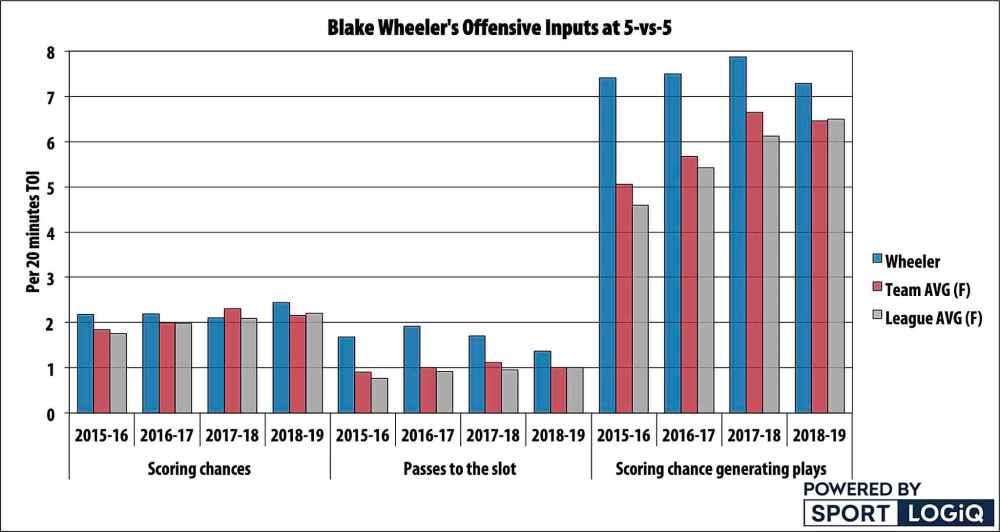Wheeler among game’s elite, but age, NHL talent closing on him
Advertisement
Read this article for free:
or
Already have an account? Log in here »
To continue reading, please subscribe:
Monthly Digital Subscription
$0 for the first 4 weeks*
- Enjoy unlimited reading on winnipegfreepress.com
- Read the E-Edition, our digital replica newspaper
- Access News Break, our award-winning app
- Play interactive puzzles
*No charge for 4 weeks then price increases to the regular rate of $19.00 plus GST every four weeks. Offer available to new and qualified returning subscribers only. Cancel any time.
Monthly Digital Subscription
$4.75/week*
- Enjoy unlimited reading on winnipegfreepress.com
- Read the E-Edition, our digital replica newspaper
- Access News Break, our award-winning app
- Play interactive puzzles
*Billed as $19 plus GST every four weeks. Cancel any time.
To continue reading, please subscribe:
Add Free Press access to your Brandon Sun subscription for only an additional
$1 for the first 4 weeks*
*Your next subscription payment will increase by $1.00 and you will be charged $16.99 plus GST for four weeks. After four weeks, your payment will increase to $23.99 plus GST every four weeks.
Read unlimited articles for free today:
or
Already have an account? Log in here »
Hey there, time traveller!
This article was published 28/09/2019 (2267 days ago), so information in it may no longer be current.
One of the most troubling aspects of the Jets’ under-performance last regular season, especially in the second half, was that Blake Wheeler’s on-ice numbers didn’t look too great, and the whole top line didn’t play opponents as strongly as they were expected to, especially given the talent at their disposal.
Concerns over Wheeler’s play have mostly been kept to those who closely follow analytics, and shrugged off by many due to back-to-back 91-point seasons, the two best years of point production in his career.
However 73 of those 182 points have come on the power play, an area where the performance of Wheeler and others on the Jets’ top line hasn’t been a problem; they’ve been brilliant. For the 33 year old, whose new contract pays him US$8.25 million starting this season until the end of the 2023-24 campaign, even-strength has been where the issue is.
It’s important to say before we take a look at Wheeler’s performance over the past few years that we’re examining one of the most dominant forwards in the NHL and one of the best two-way wingers in the game. But given his age, observers will look for signs his play might be slipping.
To look at Wheeler’s on-ice impact at even-strength, we can use a group of statistics to measure the Jets’ control of play while he’s on the ice compared to when he’s not; shots from the inner-slot or high-danger area, shots on net, shot attempts and completed passes to the slot.

Wheeler’s biggest impact as a player on both sides of the puck is on passing. He’s a phenomenal playmaker, but he’s also excellent at preventing opponents from making plays. His long reach and deceptive closing speed for a big man keeps allows him to break up passes that would evade others.
Over the last four seasons there haven’t been many players in the NHL, if any, who have had as much of an impact on passes to the slot as Wheeler has. In 2016-17, for example, the Jets completed 59.8 per cent of their passes to the slot at even-strength while Wheeler was on the ice, despite playing only 30.5 per cent of the available ice time. That is an absurd amount of the Jets’ offence being tied to one player, a testament to both his impact and the Jets not being ready for prime time that season.
Since then, the team around him has improved in that area, which accounts for some of the drop, but last season they were less effective overall, and the trend appears to be a big drop-off in effectiveness for Wheeler.
The drop-off in passes to the slot control is severe, but at least there, Wheeler is still pushing the needle more than at least 90 per cent of NHL forwards do; the real areas of concern are in shots.
After being a dominant shot driver for most of his career, the last two seasons have seen Wheeler’s performance decline significantly, with the most worrying area being shots from the inner slot.
The most dangerous shots are the ones you want to accumulate more of and deny from the opposition, and the Jets as a team failed to do that last season, which made things much harder on Connor Hellebuyck, but Wheeler’s lines in particular fell off much more than the rest of the roster.
For a player of Wheeler’s stature with the team, and with the size of his contract, that’s not good news for the Jets, but he still produced 91 points last season, and he did it while scoring seven fewer points on the power play than 2017-18, so maybe he’s fired up the quality of his offence to compensate for some drops in other areas? We can look at that while comparing him to the average forward on the Jets, and in the NHL.
Generally, the NHL as a whole shifted more towards creating quality offence at even-strength, and rewarding more offensively minded players with promotions from lower leagues and more ice time.
Usually when we look at individual offensive plays, the old axiom of “a rising tide lifts all boats” holds true. If the league loosens up a bit, offensive players produce more. If more good players are on your team, there are more opportunities for everyone to produce overall.
While Wheeler remains above league average, the gap between what he produces as a playmaker and the average Jet or average NHL forward has shrunk significantly.
In 2015-16 the average forward was creating just 4.59 scoring chances for their teammates every 20 minutes. In 2018-19, the average forward was more than 40 per cent better than that, and Wheeler produced slightly less than usual.
Over that four-year period, Wheeler has gone from being 61.4 per cent better at creating scoring chances at 5-vs-5 than the average NHL forward, to just 14.6 per cent better last season. Similarly, he hit the slot at a rate 121.1 per cent better than the average forward in 2015-16, but was just 26.3 per cent better last season.
While not being a big shooter, Wheeler’s shooting hasn’t changed much over this time compared to league average, so his regular 20 or so seems safe, but while the offensive output looks like solid gold, the inputs that create it seem to be fading a bit.
Despite this, Wheeler is still an above-average NHLer by every measure, but the decline in his game at even-strength has been real and severe. At his age, further drop-offs can happen at any time, it won’t necessarily be linear; the only real questions are when and by how much?
For the Jets, the hope has to be that things slow down and Wheeler adjusts, while his elite power-play work carries him through the contract and provides good value, but these are worrying trends to keep an eye on. It will be interesting to see if Wheeler bounces back this year, or falls off further.




.jpg?w=100)



